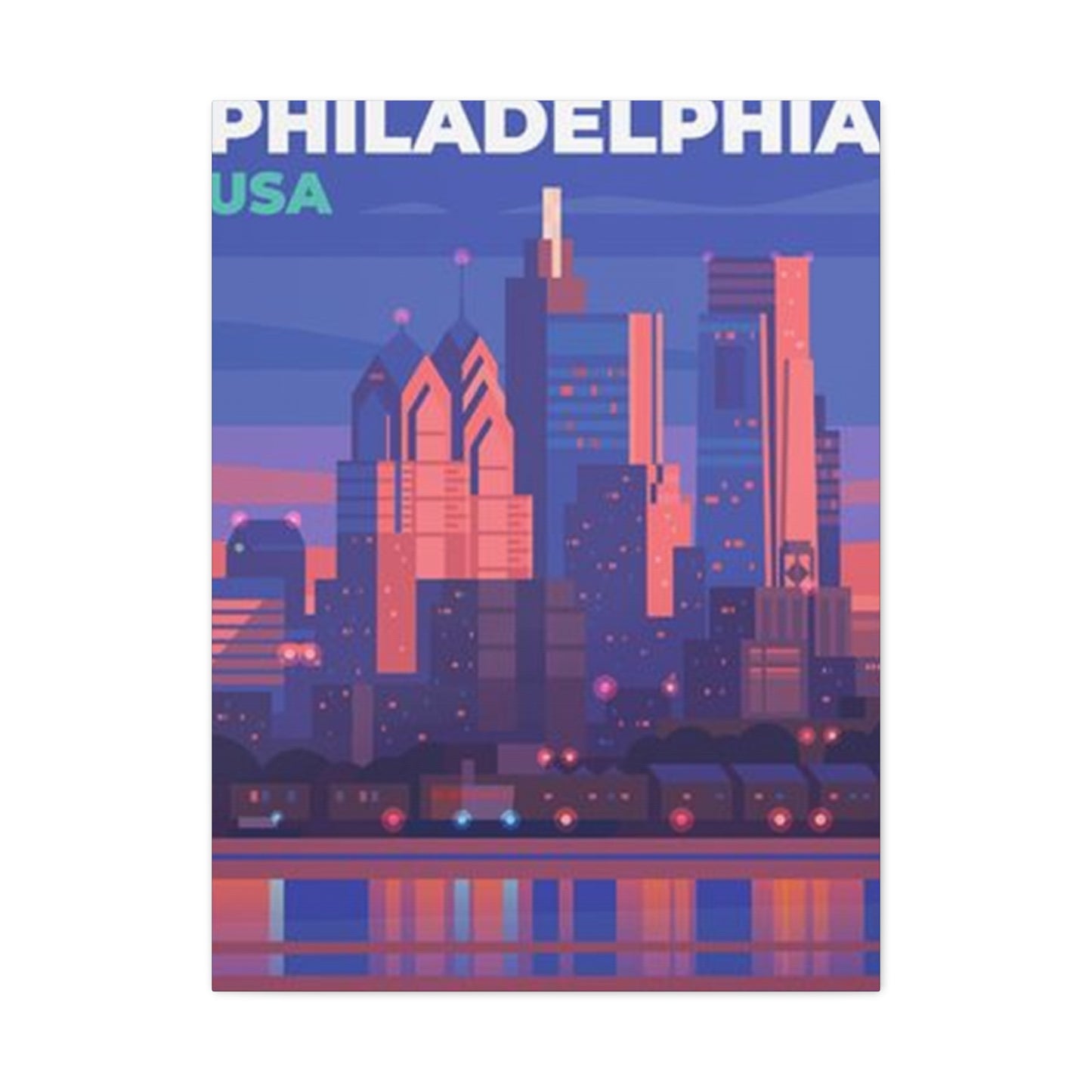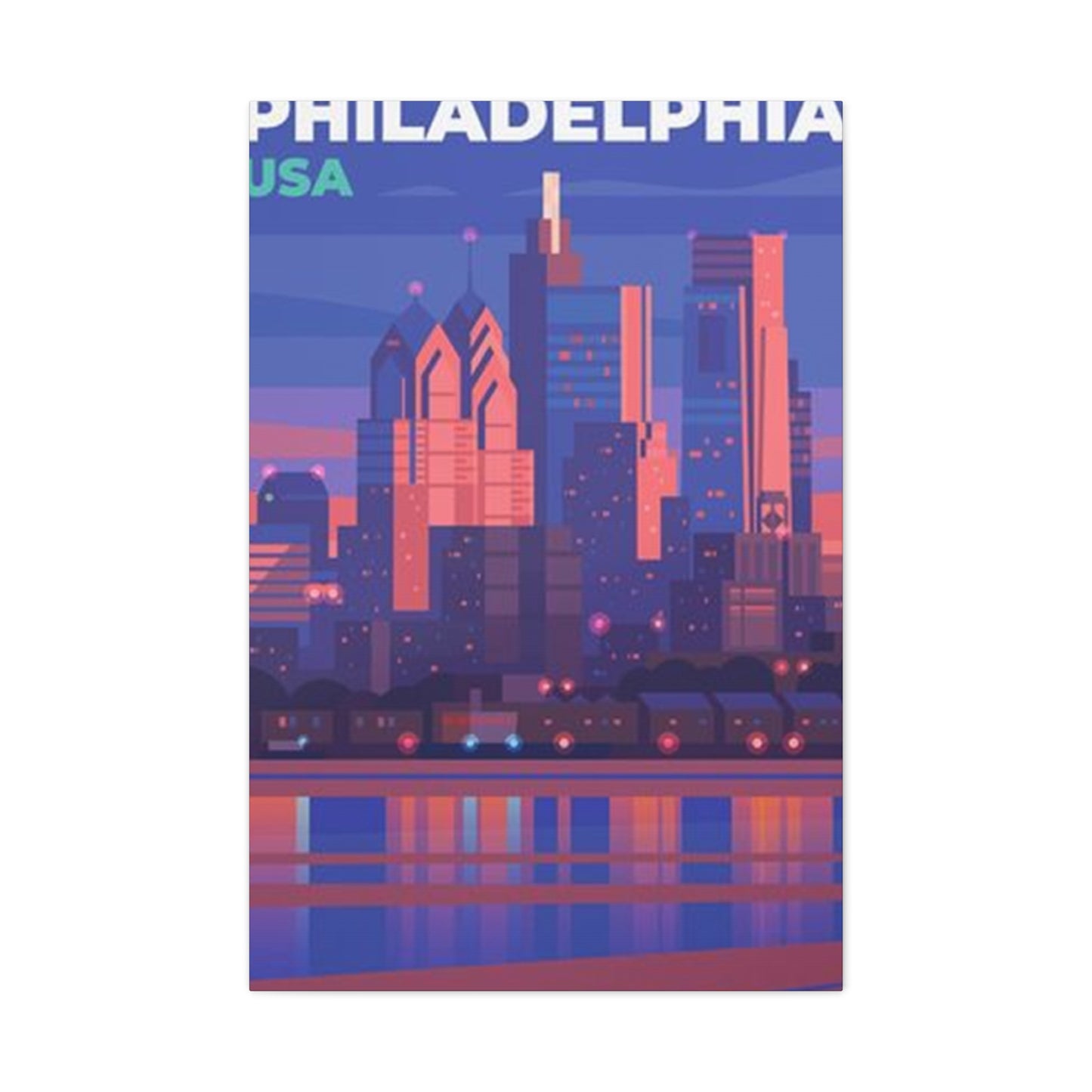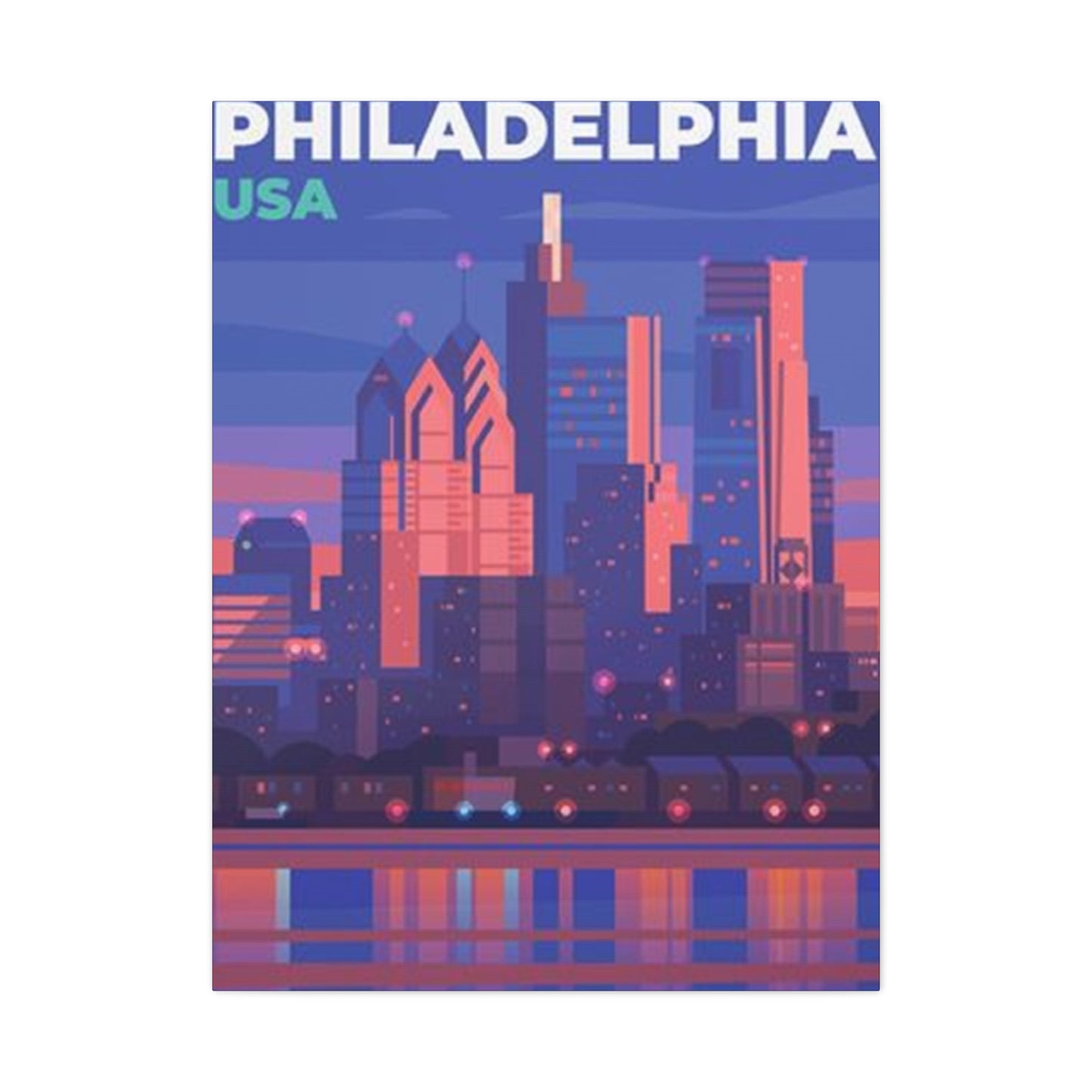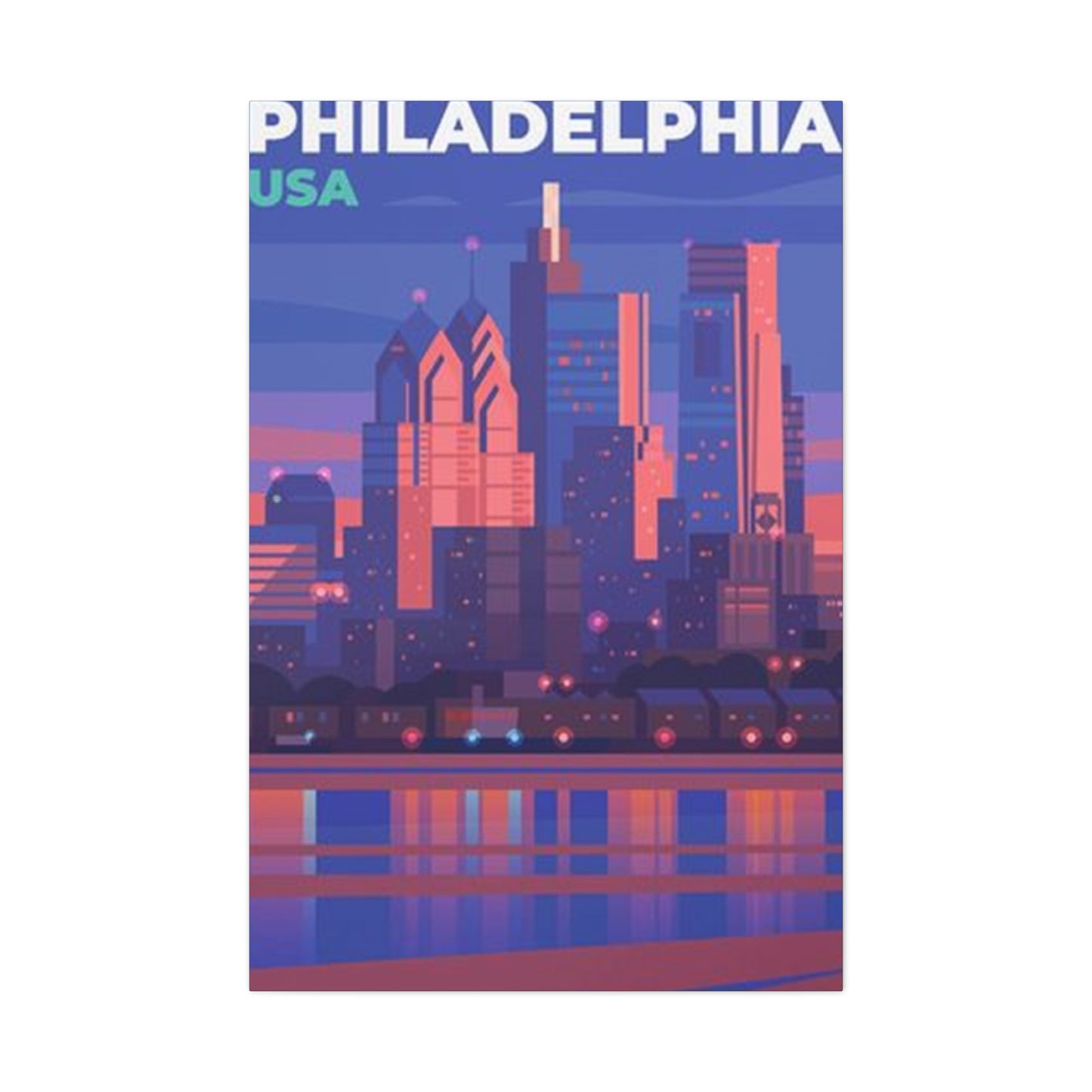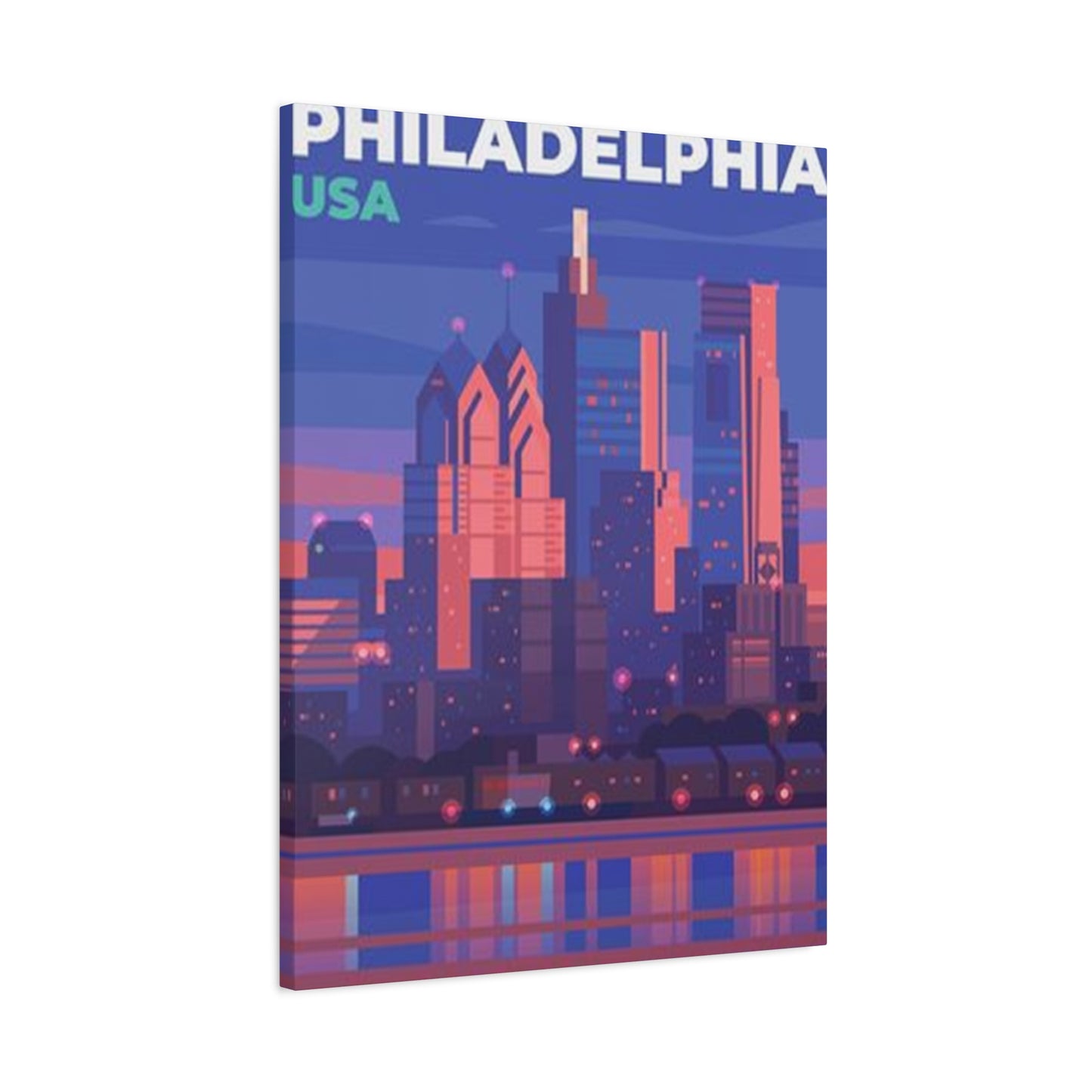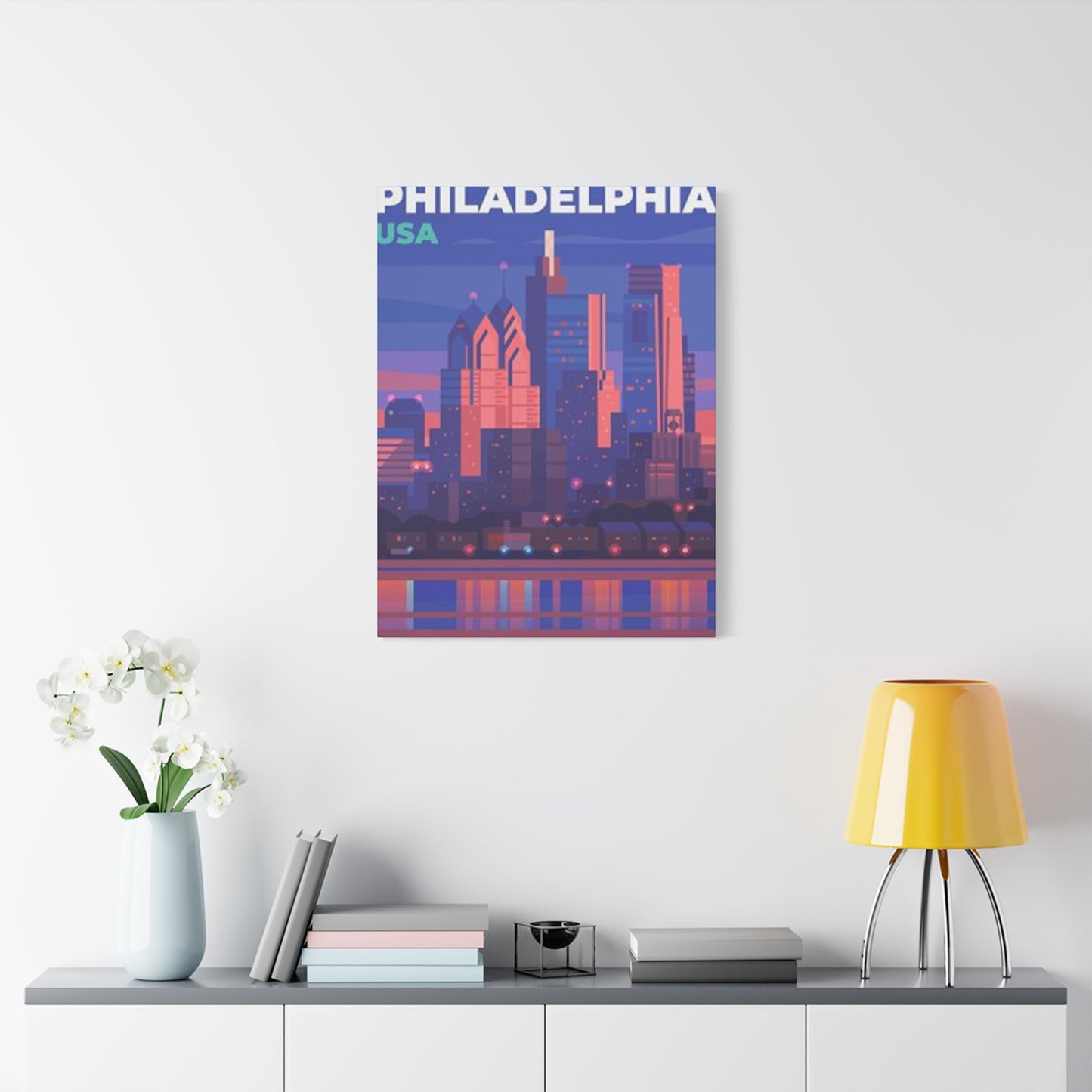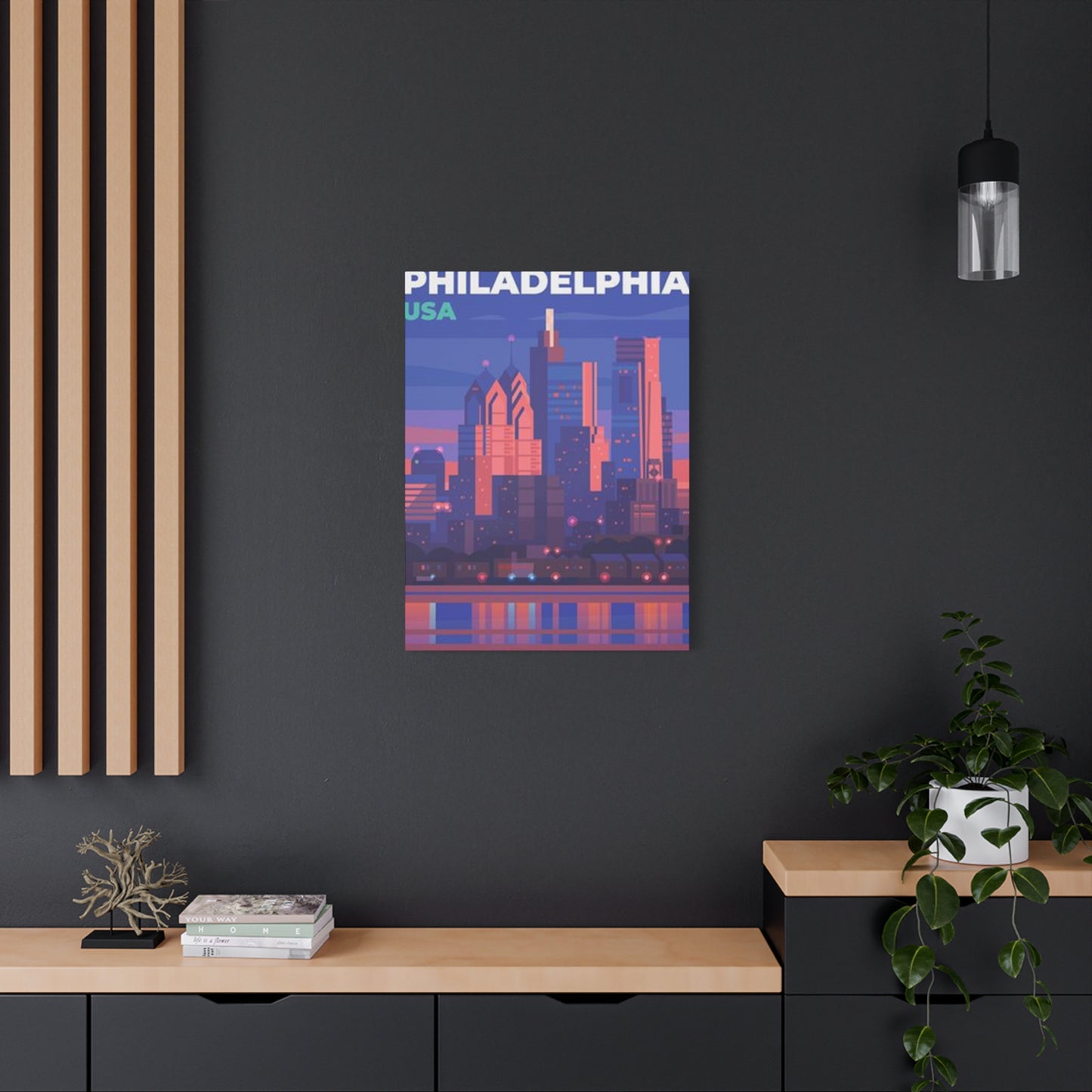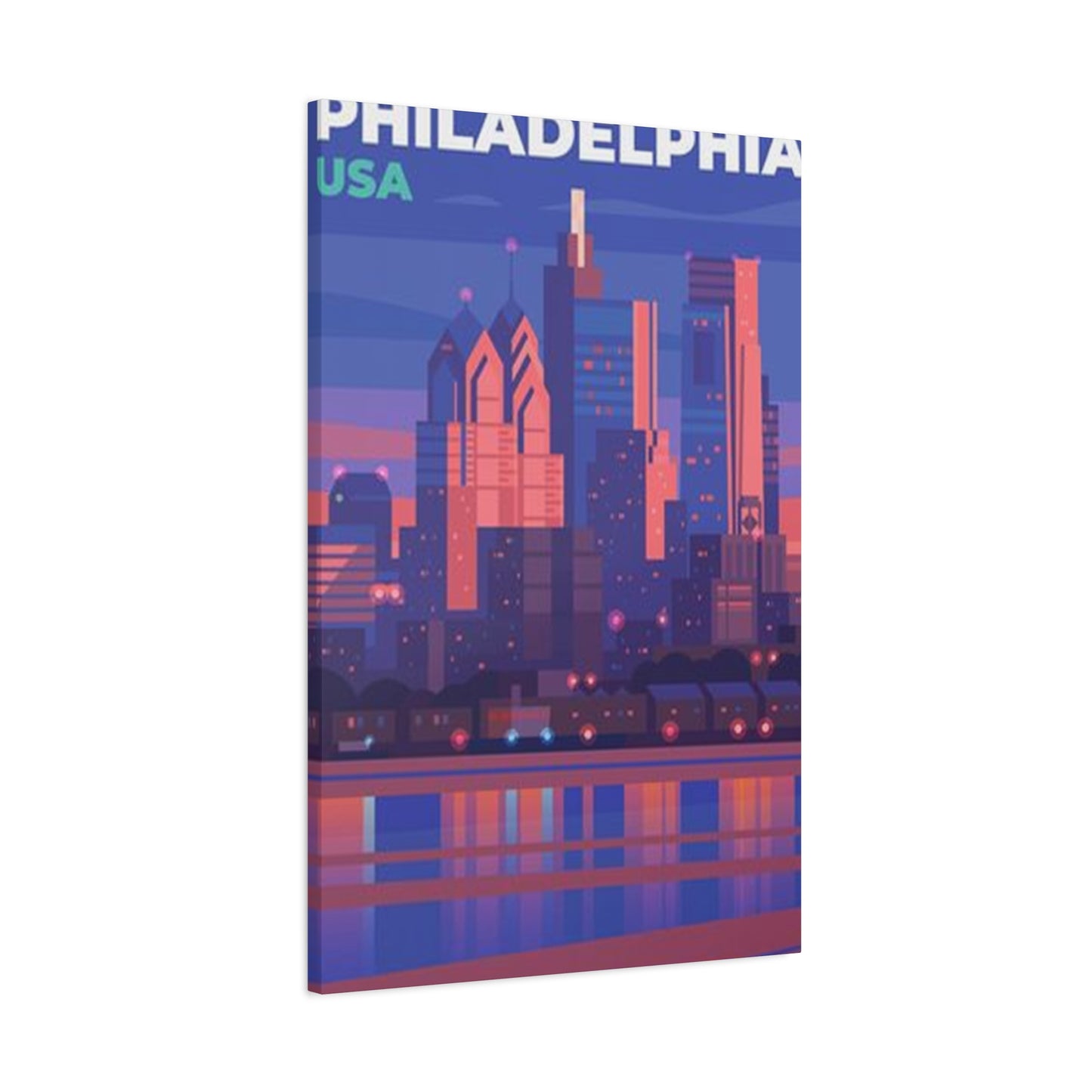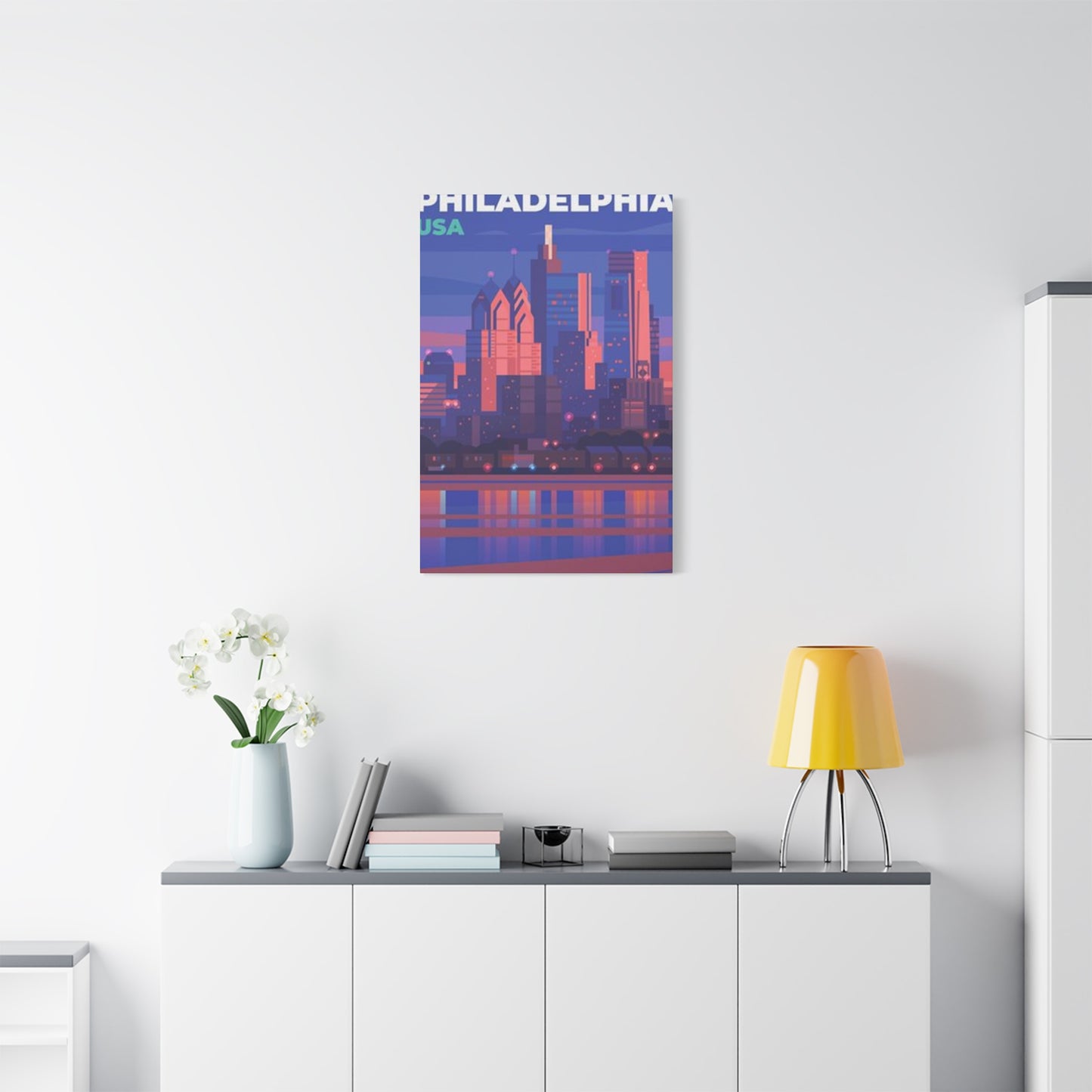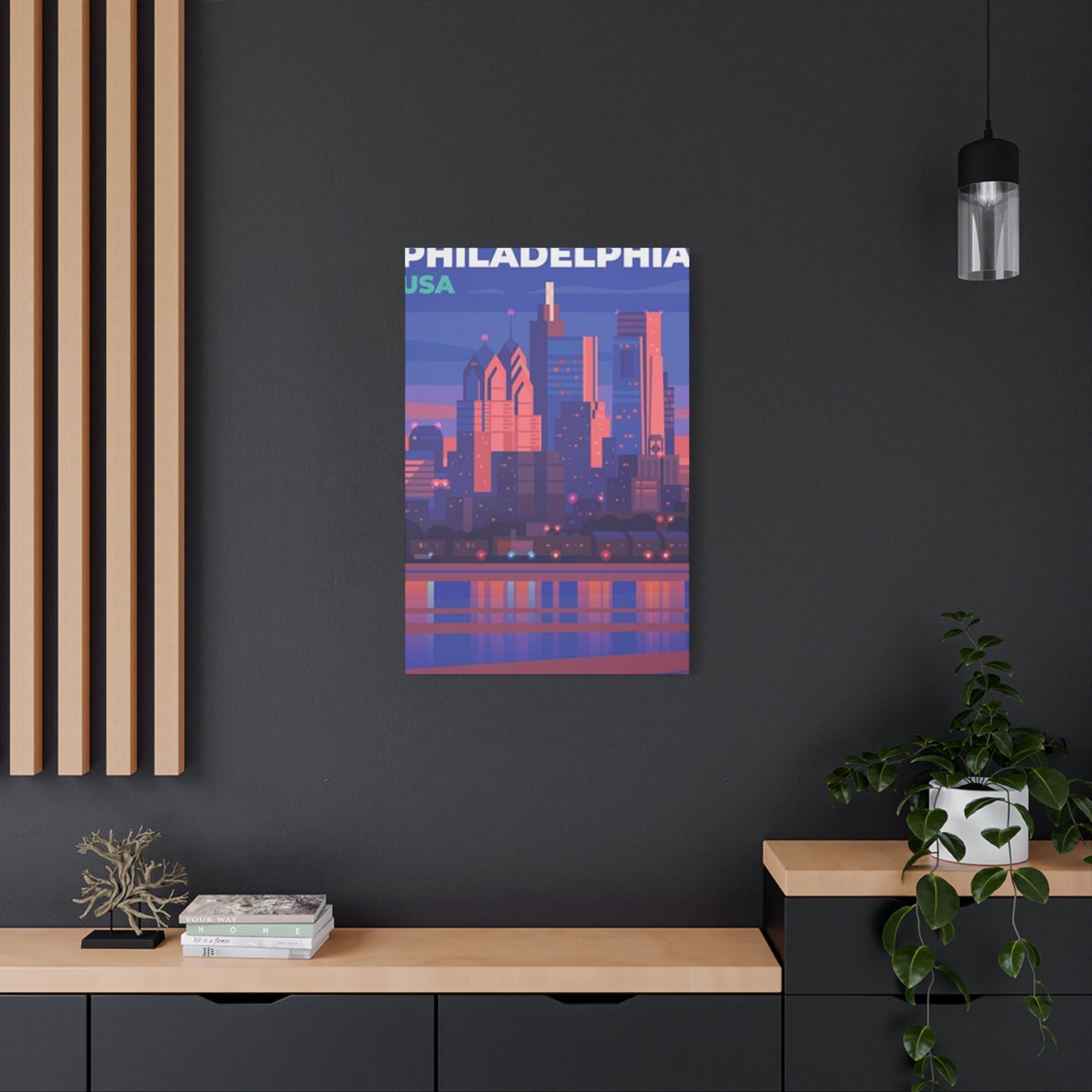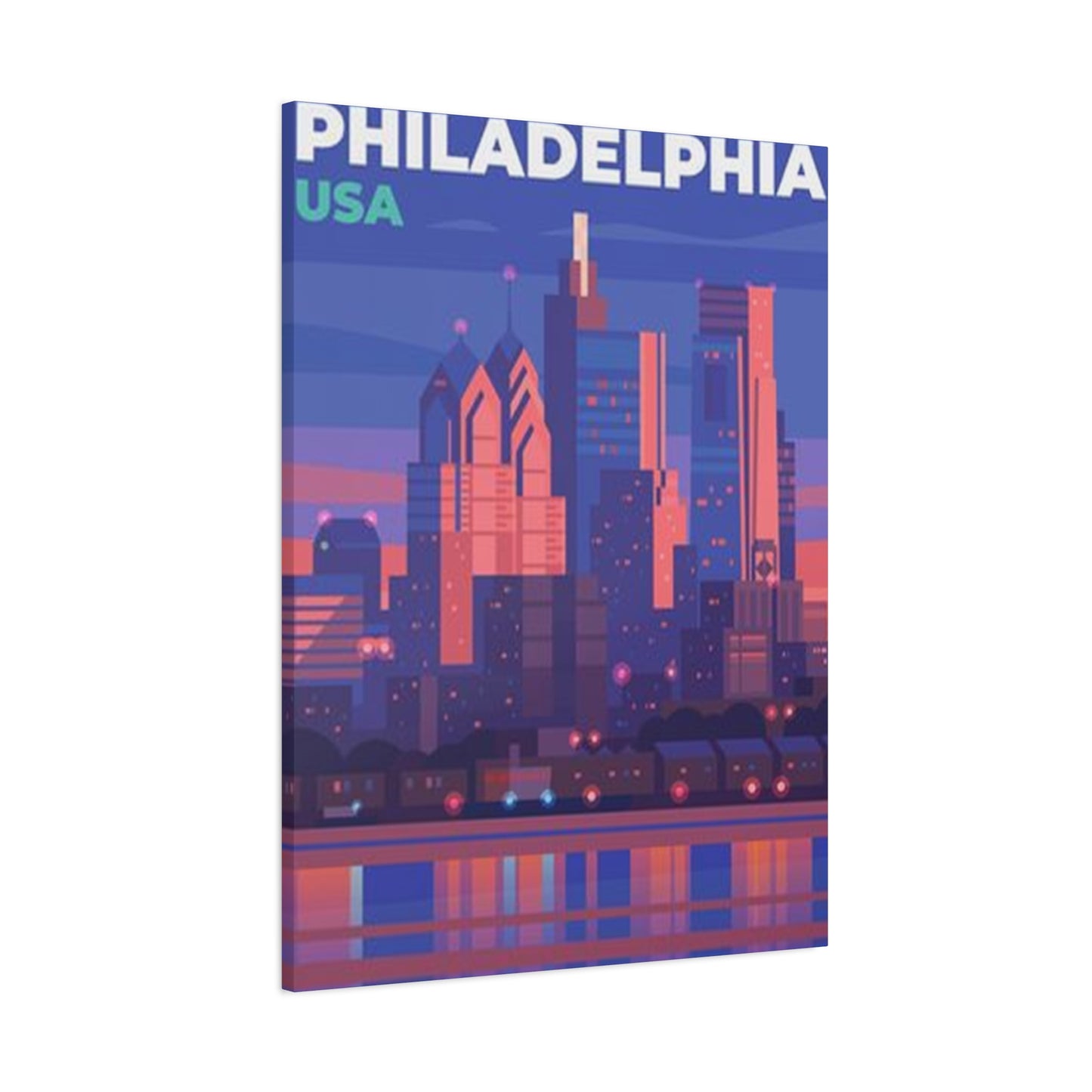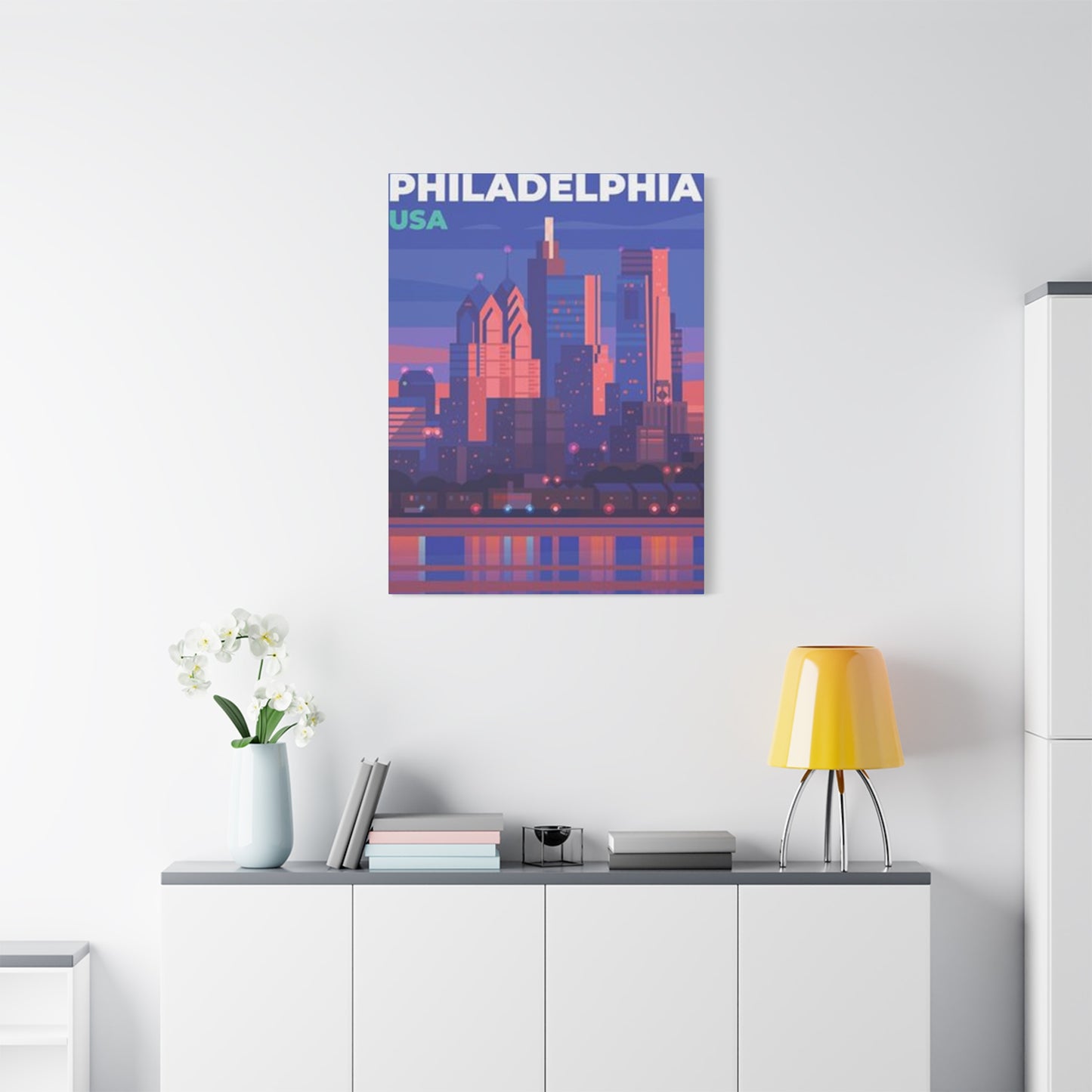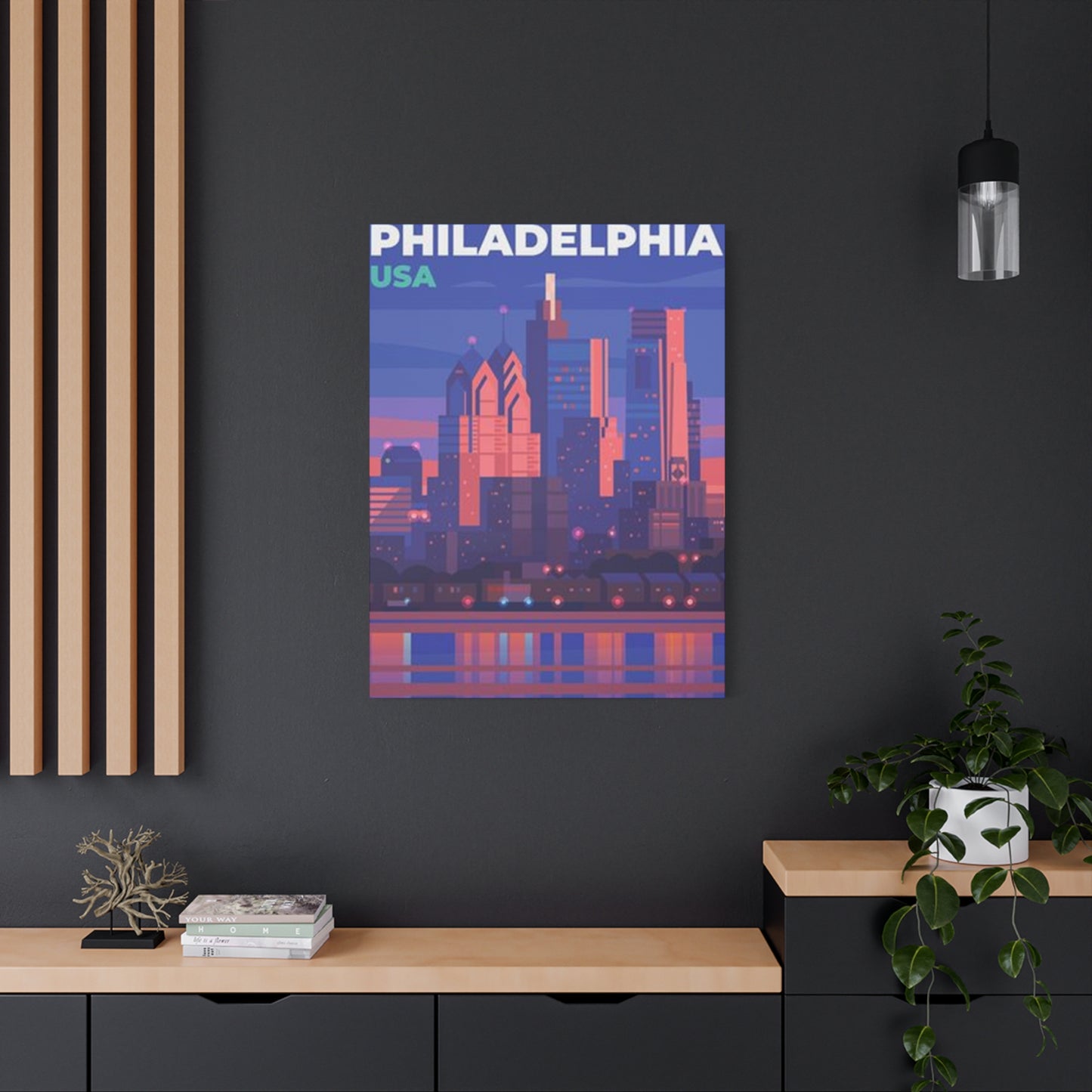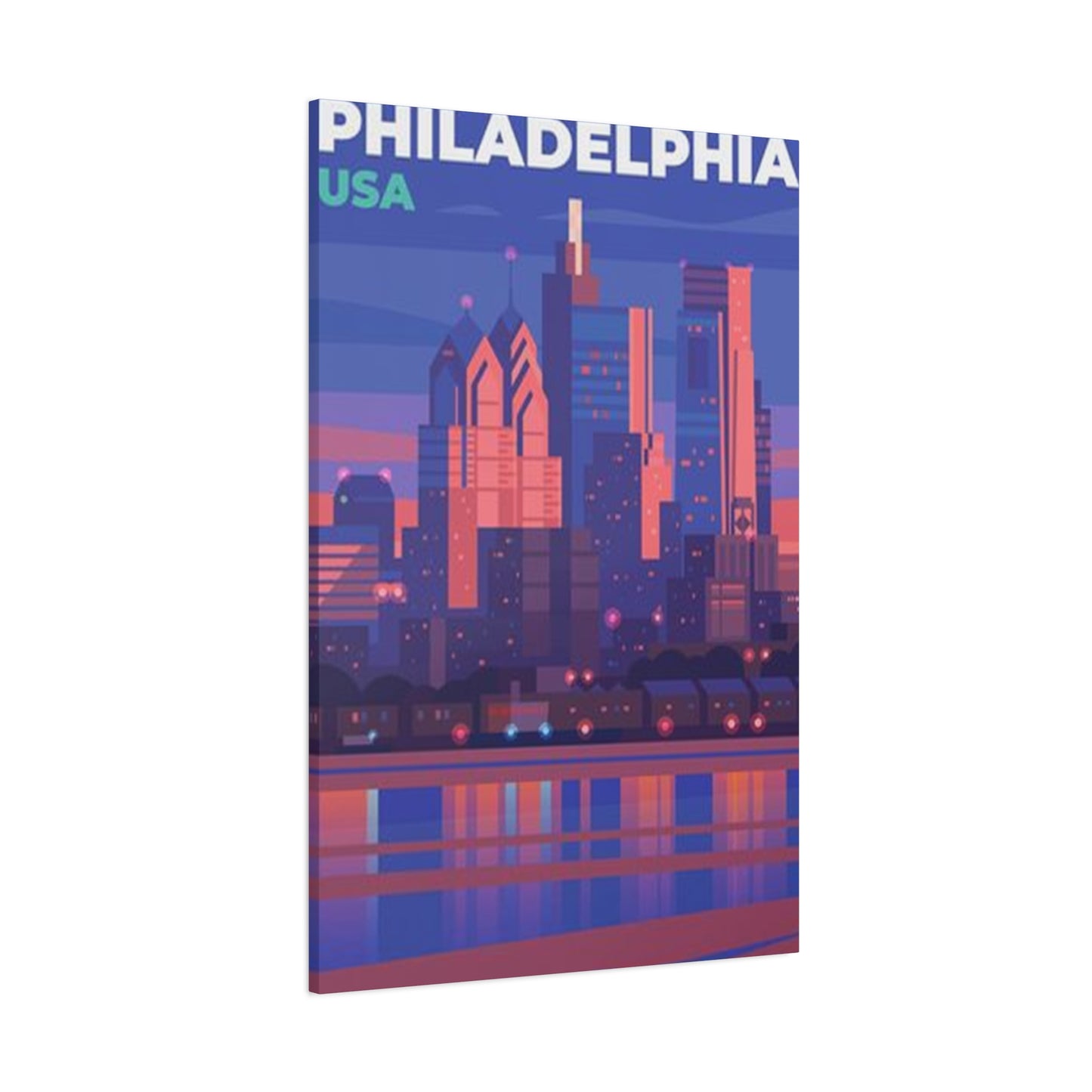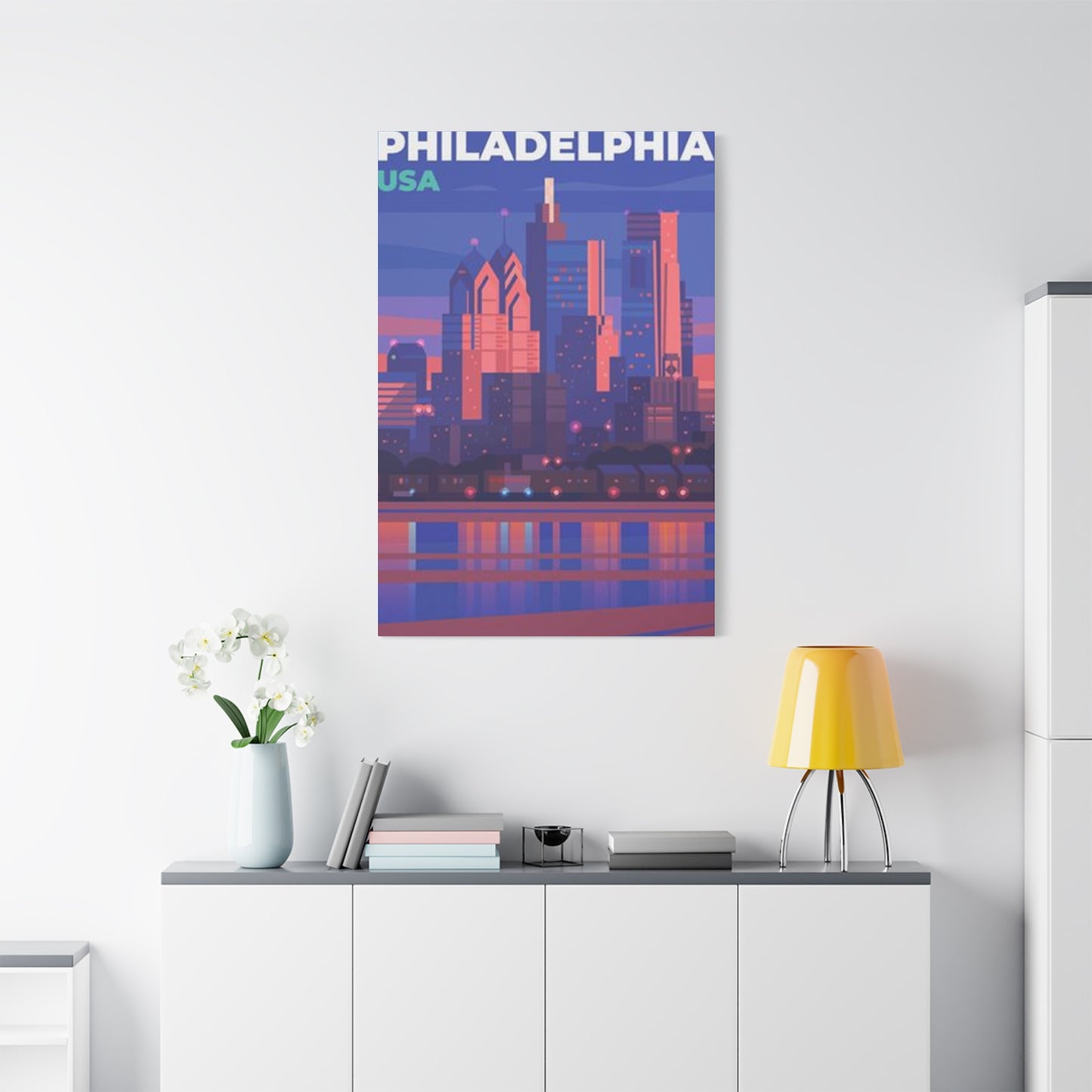Philadelphia Evening Wall Art: Capturing Philly's Majestic Twilight Cityscape Collection
Philadelphia's skyline during dusk hours presents one of the most captivating urban landscapes in America. The city's architectural marvels become silhouetted against a canvas of changing colors, creating perfect subjects for wall art that captures the essence of this historic metropolis. When the sun begins its descent behind the towering buildings, the sky transforms into a palette of warm oranges, deep purples, and golden yellows that frame the city's distinctive profile.
The iconic buildings of Philadelphia, including the towering skyscrapers of Center City, create dramatic contrasts during these magical evening hours. Each structure tells a story through its unique architectural features, from the modern glass facades that reflect the changing sky to the historic brick buildings that have witnessed centuries of American history. Artists who specialize in Philadelphia evening wall art understand how to capture these nuanced details that make the city's skyline so distinctive and memorable.
Photography and painted representations of Philadelphia's dusk skyline often focus on the interplay between natural light and urban architecture. The way shadows fall across the city's streets and buildings creates depth and dimension that translates beautifully into wall art pieces. These artworks serve as windows into the soul of Philadelphia, allowing viewers to experience the city's evening transformation from the comfort of their homes or offices.
The timing of dusk in Philadelphia varies throughout the seasons, offering artists and photographers multiple opportunities to capture the city under different lighting conditions. Summer evenings provide extended golden hour periods where the warm light bathes the entire skyline, while winter dusk arrives earlier but often brings dramatic cloud formations that add texture and interest to the sky. Each season offers unique opportunities for creating stunning Philadelphia evening wall art that showcases the city's beauty in different atmospheric conditions.
Modern wall art featuring Philadelphia's dusk skyline incorporates various artistic techniques and mediums. Some artists prefer the precision of digital photography, capturing every architectural detail with sharp clarity. Others choose painterly approaches, using oils, acrylics, or watercolors to interpret the scene with artistic license. Mixed media approaches combine photographic elements with painted or digital enhancements, creating unique pieces that blend realism with artistic interpretation.
The popularity of Philadelphia evening wall art extends beyond local residents and businesses. Visitors who have experienced the magic of Philadelphia's twilight hours often seek artwork that reminds them of their time in the city. Corporate clients frequently choose Philadelphia dusk skyline pieces for office environments, as these images convey both professionalism and a connection to the local community. The universal appeal of these artworks lies in their ability to capture a specific moment and place while evoking broader emotions about urban beauty and the passage of time.
Evening Lights Over Philadelphia Illuminate Artistic Inspiration
The evening lights of Philadelphia create a spectacular display that transforms the cityscape into a glittering jewel. As darkness approaches, thousands of windows begin to glow, creating a constellation of lights that stretches across the urban landscape. This phenomenon provides endless inspiration for artists creating wall art that celebrates Philadelphia's nighttime beauty. The contrast between the darkening sky and the warm artificial lights creates a dramatic visual impact that captivates viewers and brings energy to any room.
Street lights, building illumination, and traffic patterns contribute to the complex tapestry of Philadelphia's evening light display. The city's well-planned lighting infrastructure ensures that major landmarks and architectural features remain visible and striking throughout the night hours. Bridge lights reflect off the Delaware and Schuylkill rivers, creating shimmering pathways of light that add movement and fluidity to static architectural subjects.
Professional photographers and artists who specialize in Philadelphia evening wall art must master the technical challenges of capturing low-light scenes. Long exposure techniques reveal the movement of traffic as streaking lights, while careful timing captures the perfect balance between ambient light and artificial illumination. These technical considerations result in artworks that showcase not just the visual beauty of Philadelphia's evening lights, but also the dynamic energy of a living, breathing city.
The color temperature of different light sources throughout Philadelphia creates interesting visual contrasts in evening wall art. Warm incandescent streetlights contrast with cool LED building lights, while neon signs and digital billboards add splashes of vibrant color to the urban palette. Artists learn to use these variations to create visual interest and depth in their compositions, guiding the viewer's eye through the complex cityscape.
Seasonal changes affect the quality and character of Philadelphia's evening lights. Winter evenings may feature holiday decorations and special lighting displays that add festive elements to wall art compositions. Spring and summer evenings provide longer twilight periods where artificial lights gradually take over from natural light, creating smooth transitions that artists can capture and interpret. Autumn evenings often feature dramatic weather conditions that interact with the city's lights in interesting ways.
The emotional impact of Philadelphia evening lights wall art resonates with viewers on multiple levels. The warm glow of city lights suggests comfort, security, and human activity, while the grand scale of the illuminated skyline inspires awe and appreciation for urban achievement. These psychological effects make Philadelphia evening lights wall art particularly effective in residential and commercial environments where creating positive emotional responses is important.
Contemporary trends in Philadelphia evening wall art incorporate new lighting technologies and urban developments. LED installations, architectural lighting design innovations, and new construction projects continually change the character of the city's evening light display. Artists must stay current with these changes to create relevant and contemporary pieces that accurately represent Philadelphia's evolving nighttime character.
Painting Philly's Sunset Cityscape Requires Artistic Mastery
The art of painting Philadelphia's sunset cityscape demands both technical skill and emotional sensitivity to capture the fleeting beauty of these magical moments. Artists who tackle this challenging subject must understand color theory, atmospheric perspective, and urban composition to create compelling wall art that does justice to Philadelphia's spectacular evening displays. The rapidly changing light conditions during sunset require artists to work quickly or rely on photographic references to capture the essence of these transformative moments.
Color mixing becomes crucial when painting Philadelphia sunset cityscapes, as artists must accurately reproduce the subtle gradations of color that occur during these brief but spectacular displays. The warm colors of sunset – oranges, reds, yellows, and purples – must be carefully balanced against the cooler tones of the urban architecture and the darkening sky. Understanding how different pigments interact and how colors appear under various lighting conditions allows artists to create convincing and emotionally resonant Philadelphia wall art.
Composition plays a vital role in successful Philadelphia sunset cityscape paintings. Artists must decide which architectural elements to emphasize, how to balance the sky against the urban landscape, and where to place the horizon line to create the most impactful visual experience. The rule of thirds, leading lines, and other compositional techniques help create dynamic and engaging artworks that draw viewers into the scene and hold their attention.
The technique of atmospheric perspective becomes particularly important when painting Philadelphia's sunset cityscape. Buildings and structures that are closer to the viewer should appear more detailed and saturated, while those in the distance become hazier and less distinct due to atmospheric interference. This technique creates depth and dimension in the painting, making the cityscape appear three-dimensional and realistic despite being rendered on a flat surface.
Different painting mediums offer unique advantages for capturing Philadelphia's sunset cityscapes. Oil paints provide the ability to blend colors smoothly and work slowly to achieve subtle gradations, making them ideal for capturing the gentle transitions of sunset skies. Acrylic paints dry quickly and offer vibrant colors, perfect for artists who need to work rapidly or want to achieve bold, dramatic effects. Watercolors excel at capturing the transparency and luminosity of evening skies, though they require more skill to control effectively.
The emotional content of Philadelphia sunset cityscape paintings goes beyond mere representation of visual reality. These artworks must capture the feelings and moods associated with evening hours in the city – the end of a busy day, the promise of nighttime activities, the beauty of urban life, and the connection between human achievement and natural beauty. Successful Philadelphia wall art evokes these emotions while maintaining visual accuracy and artistic integrity.
Contemporary approaches to painting Philadelphia's sunset cityscape incorporate modern artistic movements and techniques. Some artists adopt impressionistic approaches, focusing on color and light rather than precise architectural details. Others embrace hyperrealistic styles that rival photography in their precision and detail. Abstract interpretations reduce the cityscape to essential elements of color, form, and composition while maintaining recognizable references to Philadelphia's unique character.
Night Views of Philadelphia Bridges Create Stunning Architectural Subjects
Philadelphia's bridges represent some of the most photographed and painted architectural subjects in the city's evening wall art collection. These engineering marvels span the Delaware and Schuylkill rivers, creating dramatic focal points that anchor compositions and provide strong structural elements for artistic interpretation. The Benjamin Franklin Bridge, Betsy Ross Bridge, and Walt Whitman Bridge each offer unique design characteristics that translate beautifully into wall art celebrating Philadelphia's engineering heritage and aesthetic achievements.
The lighting design of Philadelphia's bridges transforms these utilitarian structures into works of art during evening hours. Carefully planned illumination systems highlight the architectural details, cable patterns, and structural elements that define each bridge's character. The reflection of bridge lights in the water below creates symmetrical compositions that double the visual impact and add dynamic elements to static architectural subjects.
Photographers specializing in Philadelphia bridge wall art must master long exposure techniques to capture the movement of traffic across these spans while maintaining sharp definition of the structural elements. The streaking lights of vehicles create colorful ribbons that add energy and movement to bridge compositions. Timing becomes crucial, as the perfect balance between ambient light and artificial illumination occurs during a narrow window of time during evening hours.
The historical significance of Philadelphia's bridges adds narrative depth to wall art featuring these subjects. Each bridge represents a different era of engineering achievement and urban development, from the historic covered bridges to the modern cable-stayed designs. Artists can incorporate these historical elements into their compositions, creating artworks that celebrate both Philadelphia's past and present achievements in civil engineering and urban planning.
Different seasons offer varying opportunities for capturing Philadelphia bridges in evening light. Winter conditions may provide snow and ice that add textural interest to bridge compositions, while spring evenings feature clear skies that allow for clean, unobstructed views of the structures. Summer humidity can create atmospheric effects that soften distant elements, while autumn weather patterns often produce dramatic cloud formations that serve as compelling backdrops for bridge subjects.
The scale and proportion of Philadelphia's bridges create opportunities for dramatic compositions in wall art. These massive structures dominate their surroundings, allowing artists to explore themes of human achievement, engineering prowess, and the relationship between built environments and natural settings. The vertical elements of bridge towers contrast with the horizontal spans, creating dynamic tension that energizes compositions and holds viewer attention.
Contemporary bridge lighting technologies continue to evolve, providing new opportunities for Philadelphia evening wall art. LED systems allow for color-changing displays during special events and holidays, while improved efficiency and control systems create more sophisticated lighting patterns. Artists must stay current with these developments to create relevant and contemporary pieces that accurately represent Philadelphia's bridges in their current configurations.
The technical challenges of photographing or painting Philadelphia bridges at night require specialized knowledge and equipment. Camera settings must be adjusted for low-light conditions, while painters must understand how to render artificial light sources convincingly. The contrast between bright lights and dark shadows creates exposure challenges that must be managed carefully to maintain detail in both highlight and shadow areas.
Warm Tones in Philly Evening Art Evoke Emotional Connections
The warm color palette characteristic of Philadelphia evening art creates powerful emotional connections between viewers and the urban landscape. These golden, amber, and orange hues evoke feelings of comfort, nostalgia, and appreciation for the beauty found in everyday urban scenes. Artists who specialize in Philadelphia wall art understand how to leverage these warm tones to create pieces that resonate emotionally while accurately representing the city's evening character.
The source of warm tones in Philadelphia evening art varies depending on the time of year and atmospheric conditions. During summer months, the low angle of the setting sun bathes the entire cityscape in golden light, creating opportunities for artists to explore the full range of warm colors. The natural light interacts with the city's architecture, reflecting off glass surfaces and warming the color temperature of the entire scene.
Artificial lighting contributes significantly to the warm tone palette of Philadelphia evening art. Traditional incandescent street lighting, warm LED installations, and interior lighting from buildings all contribute amber and yellow tones that contrast beautifully with the cooler colors of twilight skies. The mixture of different light sources creates complex color relationships that challenge artists to accurately represent while maintaining visual harmony.
The psychological effects of warm tones in Philadelphia wall art make these pieces particularly suitable for residential and hospitality environments. Research shows that warm colors create feelings of comfort and coziness, making spaces feel more inviting and relaxing. Philadelphia evening art featuring prominent warm tones can transform cold or sterile environments into welcoming areas that encourage lingering and conversation.
Technical considerations for capturing and reproducing warm tones in Philadelphia evening art require understanding of color theory and color management. Different mediums and reproduction methods may shift color temperatures, requiring artists to compensate during creation or post-processing. Digital artists must calibrate their monitors and printing systems to ensure accurate color reproduction, while painters must understand how pigments interact under different lighting conditions.
The seasonal variation in warm tone availability creates different opportunities throughout the year for Philadelphia evening wall art. Autumn months often provide the richest warm color displays, as the low angle of the sun and atmospheric conditions enhance golden hour effects. Winter evenings may offer more subtle warm tones, requiring artists to look for them in artificial lighting sources and reflected light from snow and ice.
Compositional strategies for emphasizing warm tones in Philadelphia evening art include careful placement of light sources and warm-colored elements within the frame. Artists may use warm colors to create focal points or guide viewer attention through the composition. The contrast between warm and cool colors can create visual tension that energizes the artwork and maintains viewer interest.
Contemporary trends in Philadelphia evening wall art increasingly embrace the emotional power of warm tones. As people seek comfort and connection in their living and working environments, artworks that feature welcoming warm colors become more desirable. Interior designers and art consultants recognize the value of Philadelphia evening art with prominent warm tones for creating inviting and emotionally satisfying environments.
Philadelphia's Historic District at Twilight Preserves Architectural Heritage
The historic district of Philadelphia during twilight hours presents unique opportunities for creating wall art that celebrates the city's rich architectural heritage. The colonial-era buildings, with their distinctive brick facades and traditional proportions, create intimate and human-scaled compositions that contrast beautifully with the towering modern skyline visible in the distance. Evening light transforms these historic structures, highlighting textures and architectural details that define Philadelphia's character and historical significance.
The preservation of Philadelphia's historic architecture creates a living museum that artists can explore and interpret through evening wall art. Independence Hall, the Liberty Bell Pavilion, and numerous 18th and 19th-century buildings provide subjects that connect contemporary viewers with the city's founding principles and early development. The challenge for artists lies in capturing both the historical authenticity and the contemporary relevance of these structures.
Street lighting in Philadelphia's historic district requires careful design to maintain historical authenticity while providing adequate illumination for safety and visibility. Period-appropriate lighting fixtures cast warm, golden light that enhances the traditional architecture without overwhelming the historical character. Artists working in this area must understand how these lighting choices affect color temperature and mood in their compositions.
The cobblestone streets, brick sidewalks, and traditional building materials of Philadelphia's historic district create rich textural opportunities for wall art. Evening light reveals these textures, casting small shadows that add depth and interest to compositions. The weathering and aging of historic materials tells stories of time and use that artists can incorporate into their interpretations of these significant urban environments.
Tourism and cultural interest in Philadelphia's historic district provide ready markets for evening wall art featuring these subjects. Visitors seek mementos that capture the essence of their historical experiences, while local residents appreciate artworks that celebrate their neighborhood's unique character. The universal appeal of historical architecture ensures that Philadelphia historic district wall art resonates with diverse audiences.
The scale and proportion of historic district architecture create opportunities for intimate and personal compositions in Philadelphia wall art. Unlike the grand scale of modern skyscrapers, historic buildings relate to human proportions and pedestrian experiences. Artists can explore themes of community, tradition, and continuity while creating pieces that feel accessible and welcoming to viewers.
Conservation concerns in Philadelphia's historic district affect how artists can work in these areas. Restrictions on equipment placement, lighting setup, and access may limit photographic opportunities, while preservation requirements ensure that the historical character remains intact for future generations of artists to interpret and celebrate.
The integration of historic and modern elements in Philadelphia's historic district creates interesting compositional opportunities for evening wall art. The juxtaposition of colonial architecture with contemporary amenities and infrastructure tells the story of a living city that honors its past while embracing its future. Artists can explore these relationships to create pieces that celebrate both continuity and change.
Abstract Evening Cityscapes of Philadelphia Express Urban Energy
Abstract interpretations of Philadelphia's evening cityscape offer artists freedom to express the emotional and energetic qualities of urban life without being constrained by literal representation. These artistic approaches focus on color, form, movement, and composition to capture the essence of Philadelphia's evening character while allowing for personal interpretation and creative expression. Abstract Philadelphia wall art appeals to viewers who prefer artistic interpretation over photographic realism.
The geometric patterns created by Philadelphia's urban grid system provide natural foundations for abstract cityscape compositions. The regular patterns of streets, the repetitive elements of building facades, and the rhythmic placement of street lights create visual rhythms that artists can emphasize, modify, or completely reimagine in their abstract interpretations. These underlying structures provide organizational frameworks that prevent abstract compositions from becoming chaotic or unreadable.
Color relationships become paramount in abstract Philadelphia evening cityscapes, as artists must convey mood and atmosphere without relying on recognizable architectural details. The warm and cool color interactions characteristic of evening urban environments provide rich palettes for abstract exploration. Artists can exaggerate, simplify, or completely reimagine these color relationships to create emotional responses that transcend literal representation.
Movement and energy representation in abstract Philadelphia cityscape art often focus on the dynamic aspects of urban life rather than static architectural subjects. The flow of traffic, the patterns of pedestrian movement, and the rhythm of urban activities can be expressed through gestural brushwork, flowing compositional elements, and dynamic color transitions. These approaches create artworks that pulse with urban energy and vitality.
The emotional content of abstract Philadelphia evening wall art often proves more powerful than realistic representations because viewers must engage more actively with the artwork to derive meaning and connection. This active engagement creates stronger emotional bonds between viewers and artworks, making abstract Philadelphia cityscapes particularly effective in personal and intimate environments where emotional connection is valued.
Contemporary abstract movements and techniques find natural application in Philadelphia evening cityscape art. Expressionistic approaches emphasize emotional content over visual accuracy, while minimalist interpretations reduce urban complexity to essential elements of color and form. Mixed media approaches combine various materials and techniques to create rich, textured surfaces that suggest urban complexity without literally representing it.
The market for abstract Philadelphia evening wall art includes collectors and designers who appreciate artistic interpretation and creative expression. These pieces often serve as conversation starters and focal points in contemporary interiors where artistic sophistication and creative energy are valued. The open-ended nature of abstract art allows viewers to find personal meanings and connections that enhance the artwork's value and impact.
Technical approaches to creating abstract Philadelphia evening cityscapes vary widely depending on the artist's preferred medium and artistic philosophy. Some artists begin with realistic studies and gradually abstract them through successive iterations, while others start with pure abstract concepts and incorporate urban references as compositional elements. Digital tools offer new possibilities for creating and manipulating abstract urban compositions with unprecedented precision and flexibility.
Reflections of Philly Waterfront at Sunset Transform Urban Landscapes
The waterfront areas of Philadelphia during sunset hours provide spectacular opportunities for creating wall art that celebrates the interaction between urban development and natural water features. The Delaware and Schuylkill rivers serve as natural mirrors that double the visual impact of the city's skyline, creating symmetrical compositions that add depth and visual interest to Philadelphia evening art. The movement of water creates dynamic reflections that change constantly, challenging artists to capture specific moments or interpret the fluid nature of these subjects.
The Penn's Landing area along the Delaware River offers particularly dramatic vantage points for Philadelphia waterfront sunset art. The wide expanse of water provides unobstructed views of the city skyline while creating space for expansive sky compositions. The historic ships and modern developments along the waterfront add foreground interest that anchors compositions and provides scale references for the distant cityscape.
Water movement and surface conditions significantly affect the character of reflections in Philadelphia waterfront art. Calm water creates clear, mirror-like reflections that double the visual impact of the skyline, while choppy conditions fragment reflections into impressionistic color patches that suggest movement and energy. Artists must decide whether to capture specific water conditions or interpret the general character of waterfront reflections in their compositions.
The color relationships between sky, city, and water reflections create complex visual harmonies in Philadelphia sunset waterfront art. The warm colors of sunset skies are mirrored in the water while being modified by the water's natural color and any suspended particles or pollution. The artificial lights of the city add additional color elements that interact with both the sky colors and their reflections to create rich, complex color palettes.
Seasonal variations in water levels, weather conditions, and vegetation along Philadelphia's waterfront create different opportunities throughout the year for sunset art creation. Spring flooding may change the character of reflections and the relationship between water and shore, while winter ice conditions can eliminate reflections entirely or create unique textural opportunities. Summer and autumn typically provide the most consistent conditions for capturing classic waterfront sunset compositions.
The industrial heritage of Philadelphia's waterfront adds narrative depth to sunset art featuring these areas. Historic piers, converted warehouses, and industrial structures provide compositional elements that tell stories about the city's economic development and changing relationship with its rivers. Artists can incorporate these elements to create pieces that celebrate both natural beauty and human achievement.
Environmental concerns related to water quality and waterfront development affect both the visual character of Philadelphia's rivers and the long-term sustainability of waterfront subjects for art creation. Ongoing cleanup efforts and development projects continually change the character of waterfront areas, requiring artists to stay current with these changes while also documenting historical conditions for posterity.
The technical challenges of photographing or painting Philadelphia waterfront sunsets include managing the extreme contrast between bright sky areas and dark water surfaces. Exposure decisions must balance these extremes while maintaining detail in both highlight and shadow areas. Reflection photography requires understanding of polarizing filters and how they affect both direct light and reflected light differently.
Capturing Philly's Night Energy in Art Requires Dynamic Approaches
Philadelphia's nighttime energy manifests in countless ways throughout the city, from bustling entertainment districts to quiet residential neighborhoods where the glow of windows suggests the intimate activities of home life. Artists seeking to capture this night energy in wall art must understand not just the visual elements of nighttime urban scenes, but also the emotional and cultural factors that give Philadelphia its distinctive after-dark character. The challenge lies in translating the dynamic, temporal nature of urban energy into static visual artworks that maintain the sense of movement and vitality.
The South Street entertainment district exemplifies Philadelphia's night energy with its concentration of restaurants, bars, music venues, and pedestrian activity. The neon signs, street performers, and crowds of people create visual complexity that challenges artists to organize chaotic elements into coherent compositions. The interplay of artificial lighting from various sources creates colorful, energetic environments that pulse with activity and excitement.
Movement representation becomes crucial when capturing Philadelphia's night energy in wall art. Traffic patterns, pedestrian flows, and the general rhythm of urban activity must be suggested even in static mediums. Photographers use long exposure techniques to create light trails from moving vehicles, while painters develop gestural techniques that suggest movement and energy through brushwork and compositional elements.
The sound and music culture of Philadelphia contributes significantly to the city's night energy, though these elements must be translated into visual terms for wall art applications. The visual culture surrounding Philadelphia's music scene – from jazz clubs to rock venues to street performances – provides subjects that suggest the auditory energy of the city's nightlife. Artists often incorporate visual elements that reference musical themes or performance contexts.
Different neighborhoods in Philadelphia express night energy in unique ways that provide diverse subjects for wall art creation. The upscale dining and entertainment areas project sophisticated energy, while working-class neighborhoods may feature more intimate community gatherings and casual social activities. Each area requires different artistic approaches to accurately capture its distinctive nighttime character.
The temporal aspects of Philadelphia's night energy present both opportunities and challenges for artists. The energy builds throughout the evening, peaks during late night hours, and gradually subsides toward dawn. Artists must decide which phase of this cycle to capture and how to suggest the temporal flow of urban energy within their static compositions.
Safety and accessibility considerations affect how artists can work in Philadelphia's nighttime environment. Equipment security, personal safety, and access to optimal vantage points may limit artistic opportunities while also adding authenticity to the artistic experience. These constraints often lead to creative solutions that result in unique artistic perspectives and approaches.
The demographic diversity of Philadelphia's nighttime population creates rich opportunities for artists interested in representing the human elements of urban night energy. Different age groups, cultural communities, and social classes interact in various ways throughout the city's nighttime environment, providing subjects that celebrate the complexity and inclusivity of urban life after dark.
Philly Evening Skyline Photography Demands Technical Excellence
Professional Philadelphia evening skyline photography requires mastery of technical skills that go far beyond basic camera operation. The challenging lighting conditions, complex compositions, and high expectations for image quality demand photographers who understand exposure theory, color management, and post-processing techniques. The most successful Philadelphia skyline wall art photography combines technical excellence with artistic vision to create images that capture both the visual beauty and emotional impact of the city's evening transformation.
Camera equipment selection significantly affects the quality and character of Philadelphia evening skyline photography. Full-frame digital sensors provide advantages in low-light conditions, while specialized lenses allow for different compositional approaches. Wide-angle lenses capture expansive cityscape views, while telephoto lenses compress distances and isolate specific architectural elements. The choice of equipment affects not just image quality but also the artistic possibilities available to the photographer.
Tripod use becomes essential for Philadelphia evening skyline photography, as the long exposure times required for optimal low-light results cannot be achieved with handheld techniques. Sturdy tripods prevent camera shake while allowing precise composition adjustments during the extended shooting sessions often required to capture optimal lighting conditions. Remote shutter release systems further minimize vibration and allow photographers to capture images at precisely the right moment.
Exposure calculations for Philadelphia evening skyline photography must account for the extreme contrast between bright artificial lights and dark sky areas. Bracketing techniques and high dynamic range imaging allow photographers to capture the full range of tones present in these challenging scenes. Understanding how different light sources affect color temperature and white balance ensures accurate color reproduction in the final images.
Focus considerations become complex when photographing Philadelphia's evening skyline, as the combination of foreground elements, middle distance buildings, and distant sky requires careful depth of field calculations. Hyperfocal distance techniques maximize sharpness throughout the composition, while focus stacking methods combine multiple images to achieve unprecedented depth of field in complex scenes.
Weather monitoring and planning are essential elements of successful Philadelphia evening skyline photography. Cloud formations, atmospheric clarity, and wind conditions all affect both the visual character of the sky and the technical requirements for image capture. Professional photographers develop weather forecasting skills and maintain flexible schedules that allow them to take advantage of optimal conditions when they occur.
Post-processing workflow for Philadelphia evening skyline photography must preserve the natural character of the evening light while optimizing image quality for wall art reproduction. Color grading, contrast adjustments, and detail enhancement require careful balance to maintain authenticity while creating visually compelling results. Understanding how images will be reproduced for wall art affects post-processing decisions and output formatting.
Location scouting and timing research separate professional Philadelphia evening skyline photographers from casual practitioners. Knowledge of seasonal sun positions, optimal shooting locations, and access requirements allows photographers to plan sessions that maximize artistic opportunities while minimizing technical challenges. The most productive photographers maintain detailed location databases and timing charts that guide their shooting schedules throughout the year.
Philadelphia's Architectural Heritage Shines Through Evening Illumination
The architectural diversity of Philadelphia becomes most apparent during evening hours when artificial lighting reveals details and creates dramatic contrasts that highlight the city's rich building heritage. From colonial-era structures to contemporary skyscrapers, each architectural period contributes unique elements to Philadelphia's evening cityscape that artists can explore and celebrate through wall art. The challenge lies in understanding how different architectural styles respond to evening lighting and how to capture these characteristics effectively.
Colonial and Federal period architecture throughout Philadelphia creates intimate compositions when illuminated during evening hours. The human scale of these buildings, their traditional materials, and their historical significance provide subjects that connect viewers with the city's founding era. The warm light from period-appropriate fixtures enhances the natural colors of brick and stone while creating inviting atmospheres that suggest continuity with the past.
Victorian-era buildings in Philadelphia neighborhoods like Rittenhouse Square and Society Hill offer elaborate architectural details that become particularly dramatic under evening illumination. The decorative elements, bay windows, and varied rooflines create complex silhouettes and shadow patterns that provide rich subjects for artistic interpretation. The eclectic nature of Victorian architecture allows artists to explore themes of individuality and creative expression within urban contexts.
Industrial architecture from Philadelphia's manufacturing heritage presents bold, geometric subjects that translate effectively into evening wall art. The massive scale of factories, warehouses, and mill buildings creates dramatic compositions when illuminated against evening skies. Many of these structures have been converted to residential or commercial use, creating interesting juxtapositions between historical industrial forms and contemporary urban functions.
Art Deco and early modernist buildings in Philadelphia's Center City area demonstrate the city's participation in 20th century architectural movements. The clean lines, geometric patterns, and innovative use of materials characteristic of these styles create striking compositions when highlighted by evening lighting. The interplay between traditional and modern elements in these buildings reflects Philadelphia's evolution as a major American city.
Contemporary architecture in Philadelphia continues to evolve the city's architectural heritage while responding to current needs and aesthetic preferences. New construction projects must relate to existing architectural contexts while expressing contemporary design philosophies. Evening lighting of these new structures often incorporates LED technology and programmable systems that create dynamic displays and interactive relationships with the urban environment.
The preservation and adaptive reuse of historic buildings in Philadelphia creates opportunities for artists to explore themes of continuity and change in urban environments. Evening lighting often reveals both original architectural features and contemporary modifications, telling stories about how the city adapts to changing needs while honoring its historical character.
Building codes and lighting regulations in Philadelphia affect how structures are illuminated, influencing both their visual character and their suitability as subjects for evening wall art. Energy efficiency requirements, light pollution concerns, and historic preservation standards all shape how buildings appear during evening hours, affecting the palette of subjects available to artists working in this area.
Urban Lighting Design Philosophy Influences Artistic Interpretation
Philadelphia's approach to urban lighting design reflects both practical considerations and aesthetic values that significantly influence how the city appears in evening wall art. The coordination between public and private lighting systems creates cohesive nighttime environments that serve multiple functions while maintaining visual harmony. Understanding these design philosophies helps artists appreciate the intentional qualities of Philadelphia's evening appearance and incorporate these elements effectively into their compositions.
Street lighting design throughout Philadelphia balances safety requirements with aesthetic considerations to create functional yet attractive nighttime environments. The choice of fixture styles, light color temperatures, and mounting heights affects both the practical illumination of pedestrian areas and the visual character that artists capture in their work. Historic districts often require period-appropriate fixtures that maintain architectural authenticity while meeting contemporary safety standards.
Architectural lighting for significant buildings in Philadelphia reflects both the individual character of each structure and its role within the broader urban composition. The Philadelphia Museum of Art, City Hall, and other landmark buildings receive specialized lighting treatments that enhance their architectural features while creating dramatic focal points within the cityscape. These lighting designs consider both daytime and nighttime appearances to ensure year-round visual effectiveness.
Bridge lighting in Philadelphia demonstrates how infrastructure elements can be transformed into aesthetic features through thoughtful illumination design. The lighting systems for major bridges consider both functional requirements for navigation and safety and aesthetic goals for creating attractive nighttime landmarks. The reflection of bridge lights in the rivers below amplifies their visual impact and creates opportunities for artistic interpretation.
Commercial and retail lighting in Philadelphia's business districts creates dynamic nighttime environments that change throughout the evening as different establishments open and close. The mixture of storefront lighting, signage, and interior illumination visible through windows creates complex color relationships and visual rhythms that artists must organize into coherent compositions.
Environmental lighting considerations in Philadelphia address energy efficiency, light pollution, and ecological impacts while maintaining the visual quality that makes the city attractive to residents and visitors. Dark sky initiatives and wildlife-friendly lighting practices influence fixture selection and operation schedules, affecting both the quantity and quality of artificial light available for artistic interpretation.
Seasonal lighting programs in Philadelphia add temporary elements to the city's nighttime appearance during holidays and special events. These installations create opportunities for artists to capture unique compositions while also presenting challenges related to the temporary nature of the subjects. Understanding the schedules and locations of these seasonal displays allows artists to plan projects that incorporate these special elements.
The integration of smart lighting technologies in Philadelphia enables dynamic lighting programs that respond to various factors including time, weather, and special events. These systems create opportunities for artists to capture unique lighting conditions while also requiring adaptation to changing technological capabilities and aesthetic possibilities.
Color Theory Applications in Philadelphia Evening Art Create Visual Harmony
The successful application of color theory principles distinguishes professional Philadelphia evening wall art from amateur attempts, as artists must understand how colors interact under artificial lighting conditions and how to create harmonious compositions that accurately represent the city's evening character. The complex mixture of warm and cool light sources throughout Philadelphia creates challenging color relationships that require sophisticated understanding of color temperature, contrast, and visual balance.
Warm color dominance in Philadelphia evening art often comes from traditional incandescent street lighting, interior building lights, and the natural warm tones of sunset and twilight skies. Artists must understand how these warm colors affect the overall mood and emotional impact of their compositions while balancing them with cooler elements to create visual interest and prevent monotony. The psychological effects of warm colors make them particularly valuable for creating inviting and comfortable wall art pieces.
Cool color accents in Philadelphia evening compositions typically derive from LED lighting, moonlight, and the natural blue tones of twilight skies. These cooler elements provide essential contrast to warm-dominated compositions while adding sophistication and contemporary relevance to the color palette. The careful placement and proportion of cool colors can dramatically affect the overall impact and effectiveness of Philadelphia evening wall art.
Color temperature consistency becomes crucial when representing Philadelphia's evening lighting accurately, as different light sources throughout the city produce varying color temperatures that must be harmonized within artistic compositions. Understanding how the human eye adapts to different color temperatures and how cameras or other recording devices capture these variations allows artists to make informed decisions about color representation and correction.
Complementary color relationships in Philadelphia evening art create dynamic visual tensions that energize compositions and hold viewer attention. The natural occurrence of warm and cool color contrasts in urban evening environments provides abundant opportunities for exploring complementary relationships, though artists must apply these principles thoughtfully to avoid creating jarring or unnatural effects.
Analogous color schemes in Philadelphia evening wall art create harmonious, unified compositions that emphasize mood and atmosphere over dramatic contrast. These approaches work particularly well for creating peaceful, contemplative pieces that emphasize the serene aspects of urban evening environments. Artists working with analogous color schemes must rely on value contrasts and compositional elements to create visual interest without strong color contrasts.
Color saturation decisions significantly affect the emotional impact and stylistic character of Philadelphia evening art. Highly saturated colors create bold, energetic compositions that emphasize the excitement and vitality of urban nightlife, while desaturated palettes suggest more contemplative or nostalgic moods. The choice of saturation levels must align with the intended emotional content and target audience for the artwork.
Local color versus atmospheric color considerations require artists to understand how environmental conditions affect color appearance throughout Philadelphia's evening environment. Humidity, air pollution, and atmospheric particles all influence how colors appear at various distances, requiring artists to adjust their color choices to create convincing spatial relationships and atmospheric effects.
Conclusion
Philadelphia evening wall art beautifully captures the majestic twilight cityscape of one of America’s most historic and vibrant cities, offering an elegant way to bring the magic of Philly’s skyline and atmosphere into your living space. As day fades into night, the city’s iconic landmarks glow against the deepening sky, showcasing a blend of architectural grandeur and urban energy. This captivating moment, immortalized through art, allows residents and admirers alike to celebrate Philadelphia’s unique charm and dynamic spirit every day within their homes.
What makes Philadelphia evening wall art so compelling is its ability to evoke both nostalgia and modernity simultaneously. The interplay of warm city lights, silhouetted skyscrapers, and the subtle hues of dusk creates a mood that is both calming and inspiring. Whether depicted through photography, paintings, or digital illustrations, these works highlight the city’s rich history—from the colonial-era buildings to contemporary structures—while emphasizing the timeless beauty of twilight. This art style resonates with a wide range of interior design themes, from sophisticated urban modern to cozy industrial lofts, offering a versatile and striking focal point.
Beyond its aesthetic appeal, Philadelphia evening wall art carries a deep cultural significance. The city, known as the birthplace of American independence and a hub for arts and culture, is represented through these twilight scenes as a place of resilience, innovation, and community. Displaying such artwork can serve as a daily reminder of Philadelphia’s enduring legacy and vibrant present, inspiring a sense of pride and belonging. This connection enriches your living environment with a meaningful narrative that goes beyond mere decoration.
Philadelphia evening cityscape art also lends itself to a variety of mediums and formats. Large-scale canvas prints can transform a living room or office into a dynamic urban sanctuary, while smaller framed photographs make perfect accents in entryways or bedrooms. The use of lighting, color contrast, and perspective in these pieces can dramatically alter the atmosphere of a space, making it feel more expansive, warm, or contemplative.

















